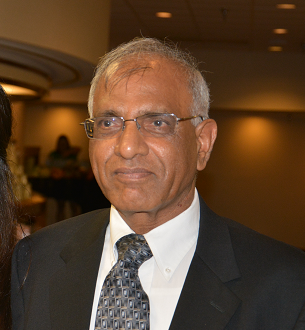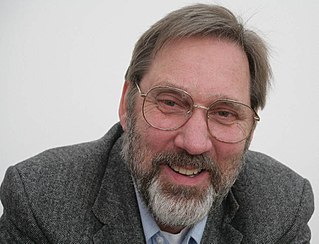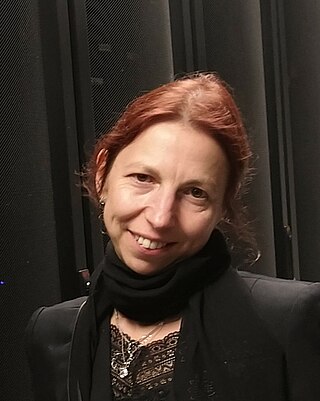Related Research Articles
A discrete element method (DEM), also called a distinct element method, is any of a family of numerical methods for computing the motion and effect of a large number of small particles. Though DEM is very closely related to molecular dynamics, the method is generally distinguished by its inclusion of rotational degrees-of-freedom as well as stateful contact and often complicated geometries. With advances in computing power and numerical algorithms for nearest neighbor sorting, it has become possible to numerically simulate millions of particles on a single processor. Today DEM is becoming widely accepted as an effective method of addressing engineering problems in granular and discontinuous materials, especially in granular flows, powder mechanics, and rock mechanics. DEM has been extended into the Extended Discrete Element Method taking heat transfer, chemical reaction and coupling to CFD and FEM into account.
Feng Kang was a Chinese mathematician. He was elected an academician of the Chinese Academy of Sciences in 1980. After his death, the Chinese Academy of Sciences established the Feng Kang Prize in 1994 to reward young Chinese researchers who made outstanding contributions to computational mathematics.
Computational mechanics is the discipline concerned with the use of computational methods to study phenomena governed by the principles of mechanics. Before the emergence of computational science as a "third way" besides theoretical and experimental sciences, computational mechanics was widely considered to be a sub-discipline of applied mechanics. It is now considered to be a sub-discipline within computational science.
Olgierd Cecil Zienkiewicz was a British academic of Polish descent, mathematician, and civil engineer. He was born in Caterham, England. He was one of the early pioneers of the finite element method. Since his first paper in 1947 dealing with numerical approximation to the stress analysis of dams, he published nearly 600 papers and wrote or edited more than 25 books.

Structural mechanics or mechanics of structures is the computation of deformations, deflections, and internal forces or stresses within structures, either for design or for performance evaluation of existing structures. It is one subset of structural analysis. Structural mechanics analysis needs input data such as structural loads, the structure's geometric representation and support conditions, and the materials' properties. Output quantities may include support reactions, stresses and displacements. Advanced structural mechanics may include the effects of stability and non-linear behaviors.

Johann Hadji Argyris FRS was a Greek pioneer of computer applications in science and engineering, among the creators of the finite element method (FEM), and lately Professor at the University of Stuttgart and Director of the Institute of Structural Mechanics and Dynamics in Aerospace Engineering.

Thomas Joseph Robert Hughes is a Professor of Aerospace Engineering and Engineering Mechanics and currently holds the Computational and Applied Mathematics Chair (III) at the Oden Institute at The University of Texas at Austin. Hughes has been listed as an ISI Highly Cited Author in Engineering by the ISI Web of Knowledge, Thomson Scientific Company.
Ray William Clough,, was Byron L. and Elvira E. Nishkian Professor of structural engineering in the department of civil engineering at the University of California, Berkeley and one of the founders of the finite element method (FEM). His article in 1956 was one of the first applications of this computational method. He coined the term “finite elements” in an article in 1960. He was born in Seattle.
Satya Atluri is an American engineer, educator, researcher and scientist in aerospace engineering, mechanical engineering and computational sciences, who is currently a Distinguished Professor Emeritus of Aerospace Engineering at the University of California, Irvine. Since 1966, he made fundamental contributions to the development of finite element methods, boundary element methods, Meshless Local Petrov-Galerkin (MLPG) methods, Fragile Points Methods (FPM), Local Variational Iteration Methods, for general problems of engineering, solid mechanics, fluid dynamics, heat transfer, flexoelectricity, ferromagnetics, gradient and nonlocal theories, nonlinear dynamics, shell theories, micromechanics of materials, structural integrity and damage tolerance, Orbital mechanics, Astrodynamics, digital Twins of Aerospace Systems, etc.

Junuthula N. Reddy is a Distinguished Professor, Regent's Professor, and inaugural holder of the Oscar S. Wyatt Endowed Chair in Mechanical Engineering at Texas A&M University, College Station, Texas, USA.[1] He is an authoritative figure in the broad area of mechanics and one of the researchers responsible for the development of the Finite Element Method (FEM). He has made significant seminal contributions in the areas of finite element method, plate theory, solid mechanics, variational methods, mechanics of composites, functionally graded materials, fracture mechanics, plasticity, biomechanics, classical and non-Newtonian fluid mechanics, and applied functional analysis. Reddy has over 620 journal papers and 20 books and has given numerous national and international talks. He served as a member of the International Advisory Committee at ICTACEM, in 2001 and keynote addressing in 2014.[2][3]
Klaus-Jürgen Bathe is a civil engineer, professor of mechanical engineering at the Massachusetts Institute of Technology, and founder of ADINA R&D, who specializes in computational mechanics. Bathe is considered to be one of the pioneers in the field of finite element analysis and its applications.
Charbel Farhat is the Vivian Church Hoff Professor of Aircraft Structures in the School of Engineering and the inaugural James and Anna Marie Spilker Chair of the Department of Aeronautics and Astronautics, at Stanford University. He is also Professor in the Institute for Computational and Mathematical Engineering, and Director of the Stanford-King Abdulaziz City for Science and Technology Center of Excellence for Aeronautics and Astronautics. He currently serves on the Space Technology Industry-Government-University Roundtable.
Eduardo Bayo is a professor in the Department of Structural Design and Analysis at the University of Navarra. He graduated with honors in civil engineering from the Polytechnic University of Madrid in 1976. After 2 years of consulting as a structural engineer with Gibbs & Hill, he attended U.C. Berkeley receiving his master's degree in Engineering in June 1980 and his PhD in January 1983, in the field of structural mechanics. He specialized in structural analysis, finite element technology and computational dynamics. After completing his PhD he led a research group at INITEC, one of the largest engineering-consulting firms in Spain, responsible for the solution of specialized problems in structural analysis and design.

Olaf O. Storaasli, Synective Labs VP, was a researcher at Oak Ridge National Laboratory and USEC following his NASA career. He led the hardware, software and applications teams' successful development of one of NASA's 1st parallel computers, the Finite element machine and developed rapid matrix equation algorithms tailored to high-performance computers to solve science and engineering applications. He was PhD advisor and graduate instructor at UT, GWU and CNU and mentored 25 NHGS students. He is recognized by American Men and Women of Science, Marquis Who's Who, and NASA, Cray, Intel and Concordia College awards. NASA Awards include Viking Mars Lander design and Engineering Analysis.

Ernest Hinton was a British civil engineer and engineering professor. He was born in Liverpool, England in 1946 and was educated at University of Wales Swansea. After receiving the BSc (1967), MSc (1968) and PhD (1971) at Swansea he joined the faculty of the Department of Civil Engineering where served until his death in 1999.

René de Borst is a Dutch civil engineer who is known for his work on computational mechanics and fracture mechanics. Since January 2016 he is the Centenary Professor of Civil Engineering at the University of Sheffield.

Somnath Ghosh is the Michael G. Callas Chair Professor in the Department of Civil & Systems Engineering and a Professor of Mechanical Engineering and Materials Science & Engineering at Johns Hopkins University (JHU). He is the founding director of the JHU Center for Integrated Structure-Materials Modeling and Simulation (CISMMS) and was the director of an Air Force Center of Excellence in Integrated Materials Modeling (CEIMM). Prior to his appointment at JHU, Ghosh was the John B. Nordholt Professor of Mechanical Engineering and Materials Science & Engineering at Ohio State University. He is a fellow of several professional societies, including the American Association for the Advancement of Science (AAAS).
Eleni Chatzi is a Greek civil engineer, researcher, and an associate professor and Chair of Structural Mechanics and Monitoring at the Department of Civil, Environmental and Geomatic Engineering of the Swiss Federal Institute of Technology in Zurich.

Sarah Anne Harris is a British physicist who is an Associate Professor of Biological Physics at the University of Leeds. Her research investigates biomolecular simulations and the topology of DNA. In particular, she makes use of molecular dynamics to explore how DNA responds to stress. She serves as chair of the Engineering and Physical Sciences Research Council (EPSRC) computational collaborative project in Biomolecular simulation.

Richard H. Gallagher was an American civil and aerospace engineer, researcher and president of Clarkson University from 1988 to 1995.
References
- ↑ "CV Barry H.V. Topping - Iran University of Science & Technology". iust.ac.ir. Retrieved 19 May 2015.
- ↑ "Hungary; b. 14.2.52, Manc". yumpu.com. Retrieved 19 May 2015.
- 1 2 "Archived copy" (PDF). Archived from the original (PDF) on 23 September 2015. Retrieved 19 May 2015.
{{cite web}}: CS1 maint: archived copy as title (link) - 1 2 3 4 5 6 "PhD conference - 2005, Pecs, Hungary". pmmf.hu. Archived from the original on 22 May 2015. Retrieved 19 May 2015.
- 1 2 3 4 "B.H.V. Topping". Elsevier. Retrieved 19 May 2015.
- 1 2 3 Who's Who in Scotland
- ↑ "The Office of Professor Barry H.V. Topping". bhvt.org.uk. Retrieved 19 May 2015.
- 1 2 "Prof. Dr. Barry Hilary Valentine Topping". pte.hu. Archived from the original on 20 May 2015. Retrieved 19 May 2015.
- ↑ "Archived copy" (PDF). Archived from the original (PDF) on 2 May 2015. Retrieved 19 May 2015.
{{cite web}}: CS1 maint: archived copy as title (link) - ↑ "Results for 'au:Topping, Barry H.' [WorldCat.org]". worldcat.org. Retrieved 19 May 2015.
- ↑ Who’s Who in Scotland
- ↑ Finite element mesh generation. OCLC 633108332.
- ↑ Topping, B. H. V.; Bahreininejad, Ardeshir (1997). Neural Computing for Structural Mechanics. Saxe-Coburg Publications. ISBN 9781874672029 . Retrieved 19 May 2015.
- ↑ Topping, B. H. V.; Khan, A. I. (1996). Parallel Finite Element Computations. Saxe-Coburg Publications. ISBN 9781874672005 . Retrieved 19 May 2015.